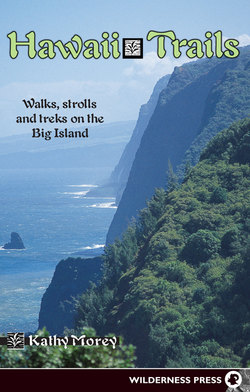Читать книгу Hawaii Trails - Kathy Morey - Страница 21
На сайте Литреса книга снята с продажи.
ОглавлениеTrip 4
Kalopa State Park—Nature Loop
Distance: ¾ mile
Elevation gain: 30 feet
Hiking time: 1 hour
Topos: Honokaa 7½
Difficulty: Very easy, tennis shoes okay
Highlights: Kalopa’s Nature Loop offers an excellent opportunity to see native Hawaiian plants in their natural setting. The attractive day-use pavilion should tempt you to stay for a picnic in spite of the area’s raininess.
Driving instructions: From Hilo, drive northwest on Highway 19 for 37½ miles—not quite as far as the turnoff to Honokaa. At the signed turnoff for Kalopa State Park, turn inland and follow country roads according to a series of signs for a zigzagging 3⅓ more miles to the entrance of Kalopa. Follow the road through Kalopa another ⅓ mile, past the caretaker’s cabin. At a fork, curve right, passing a handsome day-use pavilion, to the parking area near Kalopa’s cabins, 41½ miles. (See Appendix A for information on renting the cabins or camping at Kalopa.) Park here (or, if there isn’t room, park back down the road at the day-use pavilion and walk back to this parking lot).
Permit/permission required: None.
Description: Across the parking lot, opposite the cabins, you’ll find an information sign about Kalopa and a self-service dispenser of brochures about the park. It’s well worth your time to read the information sign and well worth the small fee for a brochure. However, most of Kalopa’s trails are no longer worth hiking (or safe for hiking); see below.
The beginning of the nature trail isn’t obvious from the parking lot. Head away from the parking lot and information sign toward a little shed that was on your right as you were facing the information sign. Keep the shed on your left as you skirt a row of trees and pass the ends of what are labeled as the Arboretum Rainforest Trail and the Arboretum Dryland Forest Trail (neither is worth bothering with). Keep left at a sign that says ENJOY THE TRAIL. PLEASE WALK WITH CARE. In about ten steps from that sign, you can stop to pick up a guide to the Nature Loop from a self-service dispenser. Continue ahead to a fork, where you bear left, just before a small gully. Innumerable insect voices sing throughout the forest; rainforest roots writhe across the muddy trail. At last you reach the fork at the beginning of the loop portion of the Nature Loop. Turn right at this fork to follow the stations as they’re laid out in the brochure. It’s time to devote your attention to the brochure, the rainforest, and the trail.
As you approach the halfway point, you climb gently toward the fenced edge of the mostly native rainforest this trail loops through. Not long ago, this forest reserve was planted with non-native species. The glimpses of cropped fields and non-native plants on the other side of the fence remind you that this native rainforest exists only because it was deliberately replanted and has been protected from encroaching non-native plants and from animals like wild pigs. Your trail curves left, past a fallen log, as you turn away from the fence and continue following the trail according to the brochure.
Common guava
The trail is sometimes hard to follow, particularly where the giant roots of a strangler fig spread across it near the ½-mile point. You need to climb over the roots of this bizarre and unwelcome intruder and then go around the left side of the fig (and the ohia it’s strangling) to regain the trail. You soon close the loop, and turn right to return to the parking lot. Be sure to return the brochure or pay for it at the information sign!
Hiking at Kalopa
Although Kalopa State Park once had a trail system, most of its trails are in such bad shape from lack of maintenance that I can recommend only this Nature Loop and the Jeep Road (Trip 5). Plants in a rainforest—which is where Kalopa is—can grow right back over a trail in no time at all. The current full-time staff of one person at Kalopa has time to maintain only the day-use and cabin areas. The overgrown, rutted, muddy remnants of some of the trails are tagged, but the tagging is inadequate. The slippery remains of the Gulch Rim Trail expose you to a nasty fall and are so overgrown you have almost no views of the gulch that’s supposed to be the attraction. One Big Island resident told me he likes to ride his mountain bike as fast as he can down the Gulch Rim Trail—another good reason to stay off it.
